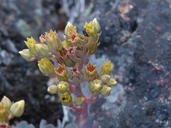Taxon Report
Sedum sanhedrinum BergerSanhedrin Mountain stonecrop |
 © 2014 Carex Working Group |
Taxon Summary
Sedum sanhedrinum, commonly known as Sanhedrin Mountain stonecrop, is a perennial herb in the Crassulaceae that is found only in California. It occurs within Chaparral, Lower montane coniferous forest, and Upper montane coniferous forest, growing at elevations from 1415 to 2285 meters. Sedum sanhedrinum is ranked 1B.2, Plants Rare, Threatened or Endangered in California and Elsewhere; Moderately threatened in California.Classification
|
Scientific Name: |
Sedum sanhedrinum Berger |
|
Common Name: |
Sanhedrin Mountain stonecrop |
| Family: | Crassulaceae |
| Element Code: | PDCRA0A260 |
| USDA Plants Symbol: | |
|
Synonyms/Other Names: |
|
Ecology and Life History
| Lifeform: | perennial herb |
| Blooming Period: May-Jul | May-Jul |
| Elevation: | 1415-2285 (4645-7495) |
| General Habitats: | Chaparral, Lower montane coniferous forest, Upper montane coniferous forest |
| Microhabitat: | Gabbroic, Metamorphic, Openings, Rock crevices, Rocky, Serpentine, Talus |
| Microhabitat Details: |
Conservation Status
| CA Rare Plant Rank: | 1B.2 |
| Global Rank: | G2G3 |
|
State Rank: |
S2S3 |
| State List: | None |
| Fed List: | None |
| Other Status: | |
|
CRPR Changes: |
|
Occurrence Data from the CNDDB
| Total Occurrences: | 21 |
| Element Occurrence Ranks: | |
| Excellent (A) | 0 |
| Good (B) | 0 |
| Fair (C) | 0 |
| Poor (D) | 0 |
| None (X) | 0 |
| Unknown (U) | 21 |
| California Endemic: False | |
| California Counties and Islands: Name (Code) | |
| Colusa (COL), Lake (LAK), Mendocino (MEN), Tehama (TEH), Trinity (TRI) | |
| Quads: Name (Quad Code) | |
| Buck Rock (3912288), Crockett Peak (3912247), Fouts Springs (3912236), Hull Mountain (3912258), Mendocino Pass (3912278), Newhouse Ridge (3912371), North Yolla Bolly (4012228), Plaskett Ridge (3912268), Raglin Ridge (4012216), Sanhedrin Mtn. (3912351), South Yolla Bolly (4012217), Tomhead Mtn. (4012227) | |
Threat List Data from the CNDDB
| Threat List Total: | 0 | |
| EOs with Threat Listed: | Total EOs | % of EOs |
| 0 | % | |
|
|
||
Selected References
| CRPR List Addition on 2021-05-14 |
| Sedum sanhedrinum account for potential Species of Conservation Concern evaluation (2022) |
Citation
California Native Plant Society, Rare Plant Program. 2025. Rare Plant Inventory (online edition, v9.5.1). Website https://www.rareplants.cnps.org [accessed 16 December 2025].